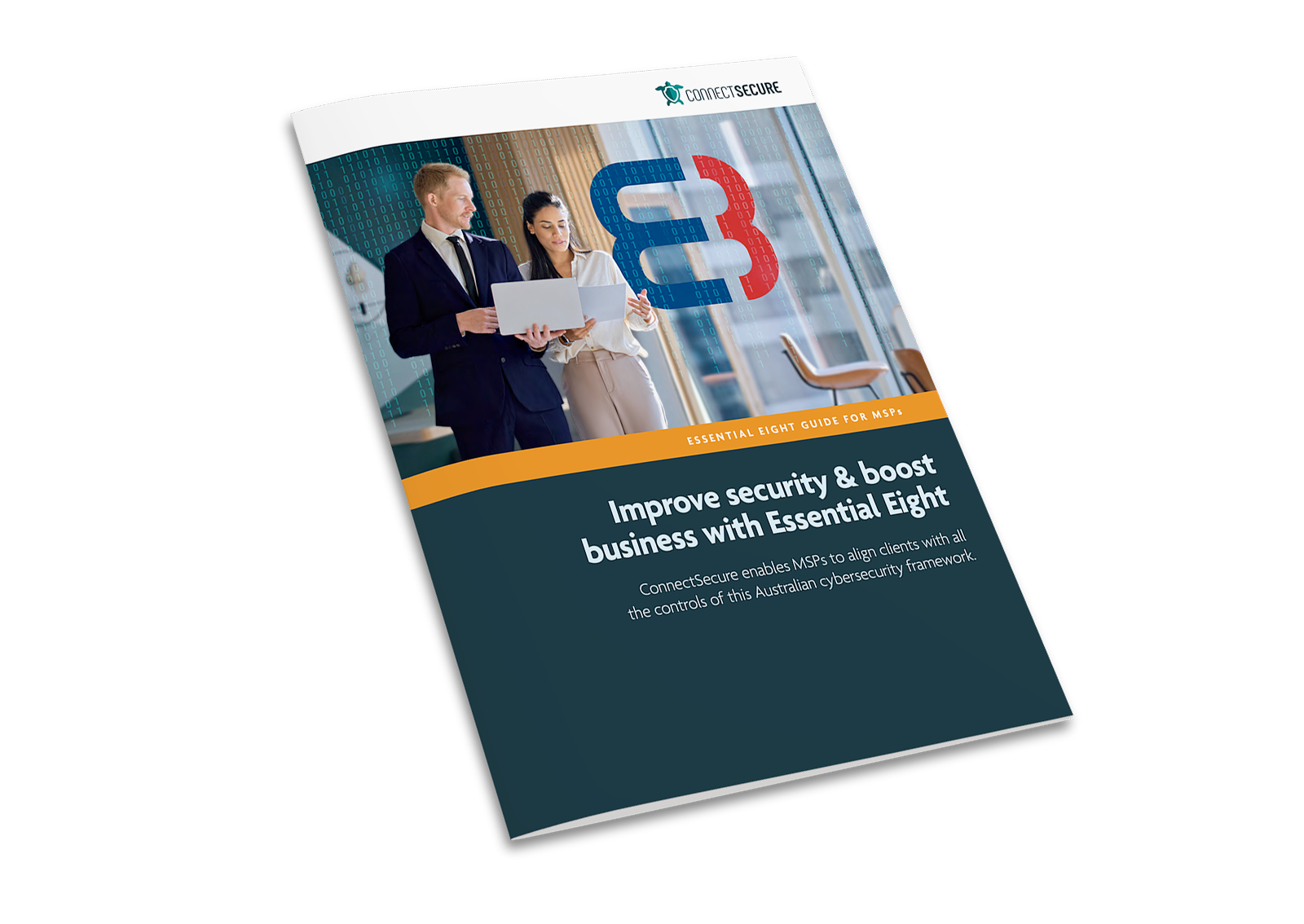Essential Eight
Essential Eight
Leverage ConnectSecure to drive business with Essential Eight compliance
Looking for new ways to position yourself as a trusted cybersecurity partner? Help your clients achieve Essential Eight compliance with ConnectSecure. By empowering them to protect their businesses from cyber threats – you reap the benefits, from advancing your market positioning to boosting customer satisfaction.
Our multi-tenant, all-in-one platform includes all the features an MSP needs to check the boxes for Essential Eight compliance: vulnerability scanning and assessment, patch management, application baseline auditing, and active directory auditing. Prove your value as a trusted cybersecurity advisor, and watch your clients' loyalty grow.
The Essential Eight compliance controls
Application Patching
Patches are often used to resolve bugs and security vulnerabilities in an application, which means they are critical to ensuring the security of those applications. Organizations should be performing vulnerability scans to identify missing patches and, when a patch for an application is released by a vendor, updates must be applied in a timeframe commensurate with their exposure to vulnerability. They should also be removing applications that are no longer supported by vendors.
Operating System Patching
Patches on operating systems are intended to fix performance bugs and address security vulnerabilities, and ensuring they are applied can prevent crashes due to software defects and extended downtime during security incidents. Organizations should conduct regular scans for patch updates and apply those updates in a timely manner. All patches for operating systems should be tested before installing to ensure that they are safe.
Multifactor Authentication
Multifactor authentication (MFA) prevents unauthorized users or threat actors from gaining access to a computing device, network, or database, and also makes it more difficult to steal legitimate credentials. Organizations should mandate two or more identifiers in addition to a password to gain access to an application or service. In so doing, unauthorized users are unable to meet the second authentication requirement, even in the case that a legitimate credential is compromised.
Restrict Administrative Privileges
When threat actors gain access to workstations or servers, they can elevate privileges to spread to other hosts, hide their existence, obtain sensitive data, or resist removal efforts. Organizations should restrict the permissions that allow users to perform certain functions on a system or network, as well as restrict access to certain applications, files, and data. With fewer users able to make significant changes and access sensitive data, the operating environment is more predictable and easier to administer.
Application Control
Application control ensures the security of systems by controlling the execution of applications based on a set of predefined rules and policies. It ensures that only approved applications can be installed and used, which prevents unauthorized users or threat actors from executing and spreading malicious code. Organizations should identify approved applications, develop control rules to ensure that only approved applications can execute, and validate the performance of these control rules on a frequent basis.
Restrict Microsoft Office Macros
Users can write macros for legitimate reasons, such as improving productivity, but they can also be written by threat actors in order to gain access to a system and perform various malicious activities. Organizations should manage the use of macros and have them checked by assessors that are independent of macro developers. Assessing the safety of a macro involves verifying if there is a business requirement for the macro, confirming that the macro has been developed by a trusted party, and ensuring that the macro is free of signs of malicious code.
User Application Hardening
Some commonly used applications can perform high-risk functions, and threat actors can exploit these functions in applications that frequently interact with the web. At the very least, organizations should disable unnecessary and/or high-risk functions in these programs. Higher cybersecurity maturity requires a more layered approach, that may involve runtime protection, application monitoring, code obfuscation, and strong authentication requirements.
Regular Backups
Backing up important data, software, and configuration settings is part of any strong incident response plan. It’s a precautionary measure that protects against hardware failure, human error, and cyber incidents, by ensuring that an organization can restore important information. Organizations should establish a regular backup routine, with regularity based in how frequently their data changes and how important that data is. There should also be access controls around backups and a process for modification and deletion.
Vulnerability Scanning: Stay ahead of threat actors with automated continuous scanning for CVEs (Common Vulnerabilities and Exposures) across software, hardware, and networks.
Prioritize Remediation: Use the Exploit Prediction Scoring System (EPSS) to identify and prioritize vulnerabilities as you guide clients through the 3 levels of Essential Eight cybersecurity maturity.
Patch Management: Customize patch management to Essential Eight standards and automate the patching process for over 600 third-party applications and diverse operating systems.
Application Baseline Audits: Define what applications are approved to run on your network and prevent unauthorized applications from executing.
Access Control: Leverage Active Directory auditing to gain visibility into user activities and access rights, enforce MFA, and deliver alerts that enable a prompt response to violations.
Device, Network and Application Discovery: Scan and catalog your clients' IT ecosystems, because you can’t protect what you don’t know.
Compliance Management: Document the compliance process, evaluate its effectiveness with thorough reporting capabilities, and share easy-to-understand results with clients.
How Your Clients Benefit from Essential Eight Compliance
Cyber threats are evolving rapidly, from ransomware attacks and phishing scams to data breaches and application vulnerabilities. As an MSP, offering Essential Eight compliance services positions you as a crucial ally in the battle against threat actors. By helping them implement these critical controls, you ensure not just their immediate security but their long-term business success as well. Here are 5 reasons Essential Eight compliance matters to your clients.
Cost Effectiveness
The cost of Essential Eight implementation is significantly less in comparison to the costs of a cyber incident, which involves remediation efforts, legal fees, and reputational damage.Enhanced Security
Essential Eight enhances the ability to detect, respond to, and recover from security incidents, minimizing operational disruption and financial loss if an incident occurs.Regulatory Compliance
While Essential Eight compliance isn’t mandatory, achieving this standard simplifies alignment with other cybersecurity frameworks. It can open doors to larger contracts and new business opportunities, especially in expanding to different regions.Improved Market Positioning
Organizations that demonstrate strong cybersecurity practices can differentiate themselves from their competitors in the marketplace and attract clients that prioritize security.Customer Satisfaction
Demonstrating compliance with Essential Eight can improve an organization's reputation as a responsible and trustworthy entity, leading to increased stakeholder confidence and loyalty.Start using ConnectSecure with a free trial!
Real results straight from our MSP community

Mitchell Matter
Co-founder | LockIT Technologies
Trent Gasser
IT Consultant | Palitto Consulting Services
Luis Alvarez
CEO | Alvarez Technology Group
Simon Hopkin
Head of Cyber Security | ITPStool for us to drive engagement. It’s very quick and easy to deploy and you get almost immediate results.”

Christophe Gagnon
Director | CyberVision 24/7
Karl Bickmore
CEO | Tech IT
Dennis Houseknecht
CTO | WatSec Cyber Risk Management
Tim Fournet
CISO | Rader